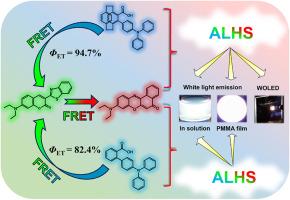Artificial light-harvesting systems for photoluminescent and electroluminescent white organic light-emitting materials
IF 4.2
3区 工程技术
Q2 CHEMISTRY, APPLIED
引用次数: 0
Abstract
Achieving efficient and stable light emission across a broad spectrum remains a critical challenge in the development of advanced organic optoelectronic materials and devices. In this study, [2.2]paracyclophane-based triphenylamine (PCP-TPA) and phenyl-based triphenylamine (Ph-TPA) were prepared and can both be used to construct innovative artificial light-harvesting systems (ALHSs) to arbitrarily regulate the emission in the visible light region. These molecules exhibit exceptional energy transfer efficiency compared to other dyes, enabling the achievement of white light emission in both solution and PMMA film. By carefully designing molecular interactions and optimizing energy transfer processes, PCP-TPA is applied to fabricate a cool white organic light-emitting diode (WOLED) with a turn-on voltage (Von) of 2.3 V, accompanied by a maximum luminance (Lmax) of 1110 cd/m2. These results highlight the significant potential of [2.2]paracyclophane derivatives in advancing the development of stable and efficient white light-emitting optoelectronic materials, and describe a method of optimizing the design of advanced light-harvesting system through molecular engineering and energy transfer optimization.

光致发光和电致发光白色有机发光材料的人工光收集系统
在先进的有机光电材料和器件的发展中,实现高效和稳定的广谱光发射仍然是一个关键的挑战。本研究[2.2]制备了基于对环蒽基的三苯胺(PCP-TPA)和基于苯基的三苯胺(Ph-TPA),均可用于构建创新的人工光收集系统(alhs),在可见光区域任意调节发射。与其他染料相比,这些分子表现出卓越的能量转移效率,使其在溶液和PMMA薄膜中都能实现白光发射。通过精心设计分子相互作用和优化能量传递过程,应用PCP-TPA制备了一种冷白色有机发光二极管(WOLED),其导通电压(Von)为2.3 V,最大亮度(Lmax)为1110 cd/m2。这些结果突出了[2.2]副环环烷衍生物在促进稳定高效白光发光光电材料发展方面的巨大潜力,并描述了一种通过分子工程和能量转移优化来优化先进光收集系统设计的方法。
本文章由计算机程序翻译,如有差异,请以英文原文为准。
求助全文
约1分钟内获得全文
求助全文
来源期刊

Dyes and Pigments
工程技术-材料科学:纺织
CiteScore
8.20
自引率
13.30%
发文量
933
审稿时长
33 days
期刊介绍:
Dyes and Pigments covers the scientific and technical aspects of the chemistry and physics of dyes, pigments and their intermediates. Emphasis is placed on the properties of the colouring matters themselves rather than on their applications or the system in which they may be applied.
Thus the journal accepts research and review papers on the synthesis of dyes, pigments and intermediates, their physical or chemical properties, e.g. spectroscopic, surface, solution or solid state characteristics, the physical aspects of their preparation, e.g. precipitation, nucleation and growth, crystal formation, liquid crystalline characteristics, their photochemical, ecological or biological properties and the relationship between colour and chemical constitution. However, papers are considered which deal with the more fundamental aspects of colourant application and of the interactions of colourants with substrates or media.
The journal will interest a wide variety of workers in a range of disciplines whose work involves dyes, pigments and their intermediates, and provides a platform for investigators with common interests but diverse fields of activity such as cosmetics, reprographics, dye and pigment synthesis, medical research, polymers, etc.
 求助内容:
求助内容: 应助结果提醒方式:
应助结果提醒方式:


